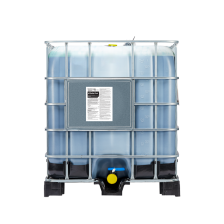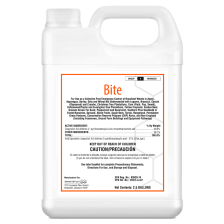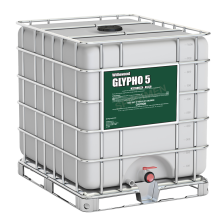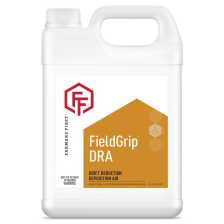2,4-D 101: Everything Farmers Need to Know About 2,4-D
This guide includes the following sections:
What Is 2,4-D?
2,4-D is a selective, systemic herbicide that can be applied as a burndown, pre-emergence, post-emergence, and pre-harvest application to control annual, biennial, and perennial broadleaf weeds in agricultural and non-agricultural settings.
2,4-D is one of the most widely used herbicides in the world and is registered for use in terrestrial and aquatic environments. In agricultural applications, 2,4-D is often used in corn, soybean, cereal grain, sorghum, and sugarcane crops. Some formulations are labeled for use in fruit, vegetable, and tree nut crops.
It is also widely used to manage pasture and fallow acres. Some 2,4-D formulations may be applied in-season over the top of tolerant crops, including cotton, corn, and soybeans. Non-agricultural applications include forestry, right-of-way, waterway, and turf management.
The active ingredient was first registered for use in the United States in 1948. In 2014, the Environmental Protection Agency (EPA) registered the first over-the-top 2,4-D herbicide, Enlist Duo® (2,4-D choline + glyphosate), for use on tolerant soybean, corn, and cotton varieties. In 2017, it followed up with a registration for Enlist® One, which only contains 2,4-D choline salt.
2,4-D Formulations
2,4-D is available in many formulations that have evolved over time. Some of the most common formulations used in agricultural applications are listed below. Generally, ester formulations are more likely to drift than salt formulations; however, amine salt formulations may not be as efficacious as ester formulations. 2,4-D choline salt formulations are less prone to drift and volatilization compared to ester and amine salts and are registered for over-the-top use on tolerant crops.
Formulation | Product Example | Notes |
2,4-D 2-ethylhexyl ester (EHE) | Ester formulations may be more volatile, especially under hot, dry conditions. They are a good choice for early spring or fall applications when temperatures are lower. 2,4-D LV4 and 2,4-D LV6 are low-volatile ester formulations that contain long-chain esters that are less prone to volatility. | |
2,4D dimethylamine (DMA) salt | Alligare Dicamba 2,4-D DMA, Weedmaster® Herbicide, Veritas® D | DMAs are typically less volatile than ester formulations, but they are also less soluble on the weed’s cuticle, resulting in less effective weed control than esters. However, they may be less likely to injure crops than esters. DMAs are a good choice for spring burndown applications where sensitive plants are a concern. |
2,4-D choline salt | Chlorine salt is registered for over-the-top use in tolerant corn, cotton, and soybean crops. It is less volatile than DMA salt and ester formulations. |
How Does 2,4-D Work?
2,4-D is a Group 4 site-of-action herbicide (synthetic auxin) in the phenoxy carboxylate family, which also includes MCPA. It mimics the natural plant hormone auxin to stimulate rapid, uncontrolled cell division in sensitive plants. Eventually, the affected plant’s vascular tissue is destroyed, leading to plant death.
Group 4 and Group 19 herbicides are collectively referred to as plant growth regulators and include dicamba, clopyralid*, and fluroxypyr active ingredients, among others.
How Long Does 2,4-D Take to Work?
Weed control timing may be highly variable (days to weeks), depending on conditions. Since 2,4-D is a systemic herbicide, favorable growing conditions will result in faster plant uptake, translocation, and weed kill. Injury symptoms may develop quickly in sensitive crops, especially under favorable growing conditions.
Variables affecting 2,4-D efficacy can include:
Temperature
Relative humidity
Rainfall following application
Soil moisture
Plant stress
Light availability
Many crops, including non-tolerant cotton, grapes, sweet potatoes, and tobacco, are susceptible to even low rates of 2,4-D, so it’s important to watch for symptoms of 2,4-D injury in non-target plants due to drift or volatilization. You may notice leaf cupping, stunted growth, or delayed or reduced crop flowering in sensitive crops exposed to 2,4-D via drift or volatilization.
2,4-D Application Best Practices
As a systemic herbicide, 2,4-D is most effective under conditions that favor healthy plant growth.
2,4-D may be used as a burndown herbicide in corn and soybean crops and is also an option for terminating cover crops ahead of cash crop planting. When using 2,4-D in spring burndown applications, it is important to follow all plant back restrictions to avoid seedling injury in emerging crops.
2,4-D may also be used post-emergence in cereal grains, sorghum, corn, and other crops to manage broadleaf weeds. Enlist® herbicides (2,4-D choline) may be sprayed over the top of 2,4-D tolerant corn, cotton, and soybeans.
Typical burndown rates for GCS 2,4-D LV 6 Ester in corn and soybeans are shown below.
Application Timing | Use Rate (pt/Ac) | Label Notes |
Preplant burndown corn | ⅔ to 1 ⅓ | For best results, growth conditions should be favorable for active weed growth. Use high rate in rate range for less susceptible weeds, cover crops such as alfalfa, weeds in advanced stages of development, or under less favorable growth conditions. Apply 7 to 14 days before planting corn to control emerged broadleaf weed seedlings or existing cover crops. |
Preplant burndown soybeans | ½ to ⅔ | Apply not less than 7 days before planting soybeans. For best results, apply when weeds are small and actively growing. Compatible crop oil concentrates, agricultural surfactants, and fluid fertilizers approved for use on growing crops may be added to spray mixtures to increase the herbicidal effectiveness on certain weeds. |
Preplant burndown soybeans | ⅔ to 1 ⅓ | Apply not less than 15 days before planting soybeans. For best results, apply when weeds are small and actively growing. Use the higher rate in the respective rate range for larger weeds and when perennials are present. Compatible crop oil concentrates, agricultural surfactants, and fluid fertilizers approved for use on growing crops may be added to spray mixtures to increase the herbicidal effectiveness on certain weeds. |
2,4-D application rates will vary depending on the:
Product
Application timing
Crop
Targeted weed species
Environmental conditions
Consult the herbicide label for specific application requirements and suitable tank mix partners.
2,4-D can damage susceptible crops through drift and volatilization. To protect non-target plants, follow label instructions and best application practices. Adding a drift reduction adjuvant, such as Tether 24™, can help keep 2,4-D spray applications on target while preventing hard water tie-up in the tank mix.
How to Tank Mix with 2,4-D
For broad-spectrum grass and broadleaf weed control, 2,4-D can be tank-mixed with compatible herbicides and applied as a burndown, pre-emergence, post-emergence, or pre-harvest application, depending on the crop. Review specific 2,4-D product labels for compatible tank mix partners and recommended adjuvants.
Common 2,4-D tank mix partners for a fall burndown application include:
Over-the-top 2,4-D herbicides may have more restrictive tank mix partner requirements. Review label requirements before tank mixing with over-the-top 2,4-D herbicides.
Are you spray-compliant? Find out what farmers need to know about the proposed EPA herbicide label updates in this FBN blog.
2,4-D Resistance Management
2,4-D has been widely used in agricultural production for decades, making it a vulnerable target for developing herbicide resistance. The International Herbicide-Resistant Weed Database reports that 44 weed species are resistant to Group 4 herbicides worldwide as of 2024.
2,4-D-resistant Palmer amaranth populations have expanded throughout the southern United States over the past decade. In 2021, a 2,4-D-resistant waterhemp population was identified in Iowa, making the herbicide less effective on these troublesome weeds.
Tips to Slow the Development of 2,4-D-Resistant Weed Populations
Make timely herbicide applications when weeds are 4” or smaller
Use multiple sites and modes of action
Employ crop rotation to diversify herbicides
Use full herbicide rates and layered residuals to extend the window of weed control
Add effective adjuvants to improve spray performance and plant uptake
Scout fields after applications to verify the application was effective
Add cultural or mechanical weed control practices, including tillage where appropriate
Learn how to manage 5,000+ pests through the FBN Pest Solutions pages.
2,4-D Human and Environmental Safety Guidelines
2,4-D Human Safety Guidelines
2,4-D generally has low toxicity for humans when best safety practices are employed, including:
Do not enter treated areas during the restricted entry interval (REI) or until the spray solution has dried. The REI may extend up to 48 hours, depending on the product’s formulation.
When handling 2,4-D, wear appropriate personal protective equipment (PPE), including a long shirt, pants, and closed-toed shoes.
Wash your hands after handling the herbicide and remove clothing and PPE immediately if the product gets on them.
Follow all label instructions to ensure the safe use of 2,4-D.
2,4-D Environmental Safety Guidelines
In general, 2,4-D is low to moderately toxic to birds, mammals, fish, and aquatic invertebrates. According to the U.S. EPA, it also has low toxicity to honeybees.
However, many specialty crops, ornamental species, and row crops are sensitive to 2,4-D exposure. To avoid off-target movement, follow all label instructions when spraying 2,4-D and use these best application practices:
Avoid applications when weather conditions favor drift or volatilization from treated areas. Even a small amount of herbicide moving off-target from treated fields may injure crops miles away.
Use the label recommended spray nozzles, spray volumes, boom height, and sprayer ground speed.
Add required and/or recommended adjuvants to reduce the risk of off-target movement.
Carefully clean equipment following a 2,4-D application. Be mindful of residual chemicals that could injure non-tolerant crops.
Buy 2,4-D from FBN
FBN offers many 2,4-D formulations to fit your broadleaf weed control needs.
Soybeans: Consider combining GCS 2,4-D LV 6 Ester and Willowood Glypho 5 as a fall burndown application.
Sorghum: Combine Alligare 2,4-D Amine*, GCS Atrazine 4L*, and bromoxynil for effective postemergence weed control in sorghum.
Enlist cotton, corn, and soybeans: Apply Enlist One or Enlist Duo®* with compatible tank mix partners for an over-the-top weed control solution in tolerant crops.
For a complete weed control solution, add label-recommended adjuvants like FieldGrip™ DRA for even more cost savings.
With a convenient online platform, transparent pricing, and direct-to-farm delivery available on your schedule, FBN puts Farmers First®.
Related Resources
Acetochlor 101: Everything Farmers Need to Know About Acetochlor
Atrazine 101: Everything Farmers Need to Know About Atrazine
Bifenthrin 101: Everything Farmers Need to Know About Bifenthrin
Biostimulants 101: Everything Growers Need to Know About Biostimulants
Clopyralid 101: Everything Farmers Need to Know About Clopyralid
Clethodim 101: Everything Farmers Need to Know About Clethodim
Crop Nutrition 101: Everything Farmers Need to Know About Crop Nutrition
Fungicides 101: Everything Farmers Need to Know About Fungicides
Glyphosate 101: Everything Farmers Need to Know About Glyphosate
Glufosinate 101: Everything Farmers Need to Know About Glufosinate
Herbicides 101: Everything Growers Need to Know About Herbicides
Inoculants 101: Everything Farmers Need to Know About Inoculants
Insecticides 101: Everything Farmers Need to Know About Insecticides
Lambda-Cyhalothrin 101: Everything Farmers Need to Know About Lambda-Cy
Metolachlor: Everything Farmers Need to Know About Metolachlor
Nitrogen 101: Everything Farmers Need to Know About Nitrogen
Paraquat 101: Everything Farmers Need to Know About Paraquat
Copyright © 2014 - 2025 Farmer's Business Network, Inc. All rights Reserved. The sprout logo, “Farmers Business Network”, "Farmers First", “FBN”, “FBN Direct,” and “FieldGrip” are servicemarks, trademarks or registered trademarks of Farmer's Business Network, Inc.
The following Trademarks are the property of their Owners as listed, or their affiliates. BASF: Sharpen powered by Kixor Corteva AgriScience: Enlist, Enlist One and Enlist Duo Innvictis Crop Care LLC: Veritas D Nufarm: Weedmaster
All other trademarks are the property of their respective owners.
Clopyralid is a restricted-use pesticide.
Bite is a restricted-use pesticide.
GCS Atrazine 4L is a restricted-use pesticide.
Sharpen® powered by Kixor® herbicide is a restricted-use pesticide.
Willowood Paraquat 3SL is a restricted-use pesticide.
Alligare 2,4-D Amine is a restricted-use pesticide.
Enlist Duo™ Herbicide with Colex D Technology is a restricted-use pesticide.
*Restricted Use Pesticides due to acute toxicity. For retail sale to and use by certified applicators only – NOT to be used by uncertified persons working under the supervision of a certified applicator.
FBN Direct products and services and other products distributed by FBN Direct are offered by FBN Inputs, LLC and are available only in states where FBN Inputs, LLC is licensed and where those products are registered for sale or use, if applicable. If applicable, please check with your local extension service to ensure registration status. Nothing contained on this page, including the prices listed should be construed as an offer for sale, or a sale of products. All products and prices are subject to change at any time and without notice. Terms and conditions apply.
ALWAYS READ AND FOLLOW LABEL DIRECTIONS. It is a violation of federal and state law to use any pesticide product other than in accordance with its label. The distribution, sale and use of an unregistered pesticide is a violation of federal and/or state law and is strictly prohibited. We do not guarantee the accuracy of any information provided on this page or which is provided by us in any form. It is your responsibility to confirm prior to purchase and use that a product is labeled for your specific purposes, including, but not limited to, your target crop or pest and its compatibility with other products in a tank mix and that the usage of a product is otherwise consistent with federal, state and local laws. We reserve the right to restrict sales on a geographic basis in our sole discretion. You must have a valid applicator license to use restricted use pesticides. Please consult your state department of agriculture for complete rules and regulations on the use of restricted use pesticides, as some products require specific record-keeping requirements.
The material provided is for educational purposes only. It is not intended to be a substitute for specific agronomic, business, legal, investment or professional advice. Where specific advice is necessary or appropriate, consult with a qualified agronomist, financial planner, or investment manager. Neither Farmer's Business Network, Inc. nor any of its affiliates makes any representations or warranties, express or implied, as to the accuracy or completeness of the statements or any information contained in the material and any liability therefore is expressly disclaimed.








